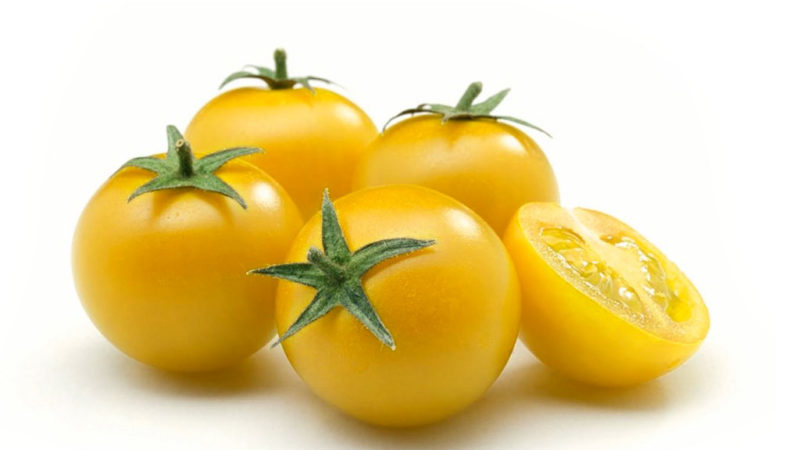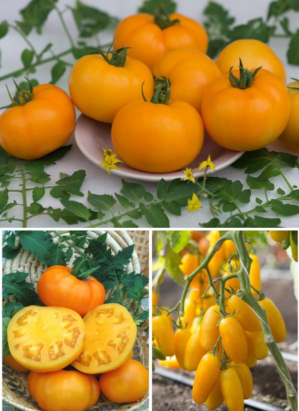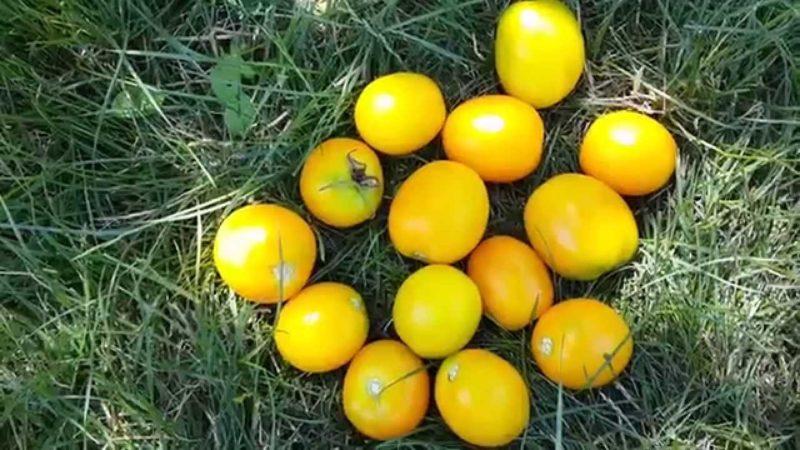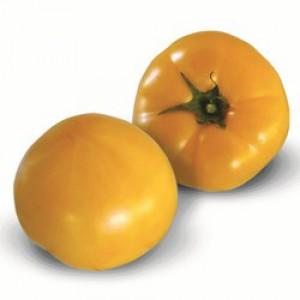Features of caring for yellow-fruited tomatoes
In addition to the usual red tomatoes, gardeners are also attracted by unusual varieties. For example, yellow tomatoes. Varieties of yellow tomatoes are the best option for those who are allergic to red tomatoes. The yellow vegetable is an excellent antioxidant with a sweet, rich taste.
The best varieties, their advantages and disadvantages, and features of growing and care - consider further.
The content of the article
Features of yellow tomatoes
Yellow tomatoes can be consumed by people allergic to red varieties. This vegetable will not harm young children, people on a diet, and even diabetics. The taste differences of these varieties are that they are much sweeter than its red relatives.
The vegetable contains a lot of nutrients. When consumed, the body is cleansed of toxins, toxins and half-life products. The blood composition improves and the risk of cancer is reduced. Yellow tomato is good for kidneys and liver.

Description, characteristics and yield
Gardeners fell in love with yellow-fruited tomatoes for their excellent taste and beautiful rich color. Such fruits are used for dietary and baby food.
The most delicious and productive yellow tomato varieties:
- Kazakhstani yellow. The growth of the bush reaches 2 meters, has a massive stem and small leaves. The tomato ripens early and bears a bountiful harvest. They are grown both by seedlings and by direct sowing into the ground. This vegetable has long-term fruiting, allowing you to enjoy the fruits throughout the summer-autumn season. The tomatoes themselves grow large, but there are also small ones. The average weight of vegetables is 550 g. Kazakh yellow tomato is best consumed fresh.
- Golden bullet. The plant is determinant, of short stature, about 50-60 cm. The tomato is early maturing, grown both in the open field and in the greenhouse. Ripening of the first fruits - 100-105 days after planting, the weight reaches 50-60 g. From 1 sq. m, an average of 3 kg of tomato is harvested. The variety is distinguished by sweetness, juiciness and pleasant aroma. Resistant to major diseases. Tomatoes are well suited for preservation, as they are lightweight, oval and have a consistent texture.
- A barrel of honey. The bushes are strong, tall, reaching up to 1.8 m, they need a garter to the support and pinching. The tomato is indeterminate, large-fruited, the fruits gain weight up to 400 g. At maturity it has a flat-round shape and orange color. Fruits are fragrant, sweet, fleshy, do not spread when cut. From germination to fruiting, it takes about 100-110 days. On average, from 1 sq. m harvest 7 kg. The plant is resistant to disease.
- Amana orange. Mid-season and tall variety. It is desirable to grow tomatoes in two stems with pinching. Fruits are bright orange in color; when fully ripe, there may be red strokes on the top. They have a flat-round shape. Average weight 300 g. The taste is sweet, aromatic, fleshy, juicy, contains few seeds. Used for salads, preservation, juices. It is recommended to grow in a greenhouse.
Pros and cons of yellow tomatoes
Yellow-fruited tomatoes promote the breakdown of fats, accelerate the growth of young cells and metabolic processes in the body. Studies have shown that the vegetable can be used as an antidepressant.
In addition, yellow tomatoes have:
- low calorie content;
- hypoallergenic;
- low acidity;
- contain niacin, which strengthens the walls of blood vessels;
- contain vitamin C and lycopene;
- an increased content of carotene (a mineral that is useful for visual function).
The only significant disadvantage is yield. For such tomatoes, it is average.
Features of growing and caring for yellow-fruited tomatoes
Growing yellow-fruited varieties of tomatoes consists of several stages, at each of which it is important to follow a special technology. The varieties are grown both in the greenhouse and in the open field (mainly in the southern regions of the country).
Seed preparation
Fruit growing begins with seed preparation. If the seeds have not been processed by the manufacturer, the preparatory work is carried out independently.
With seeds with a natural light brown color and a small fluff, do the following:
- Sorting. Place seeds in 5% sodium chloride solution. The strongest will sink to the bottom of the container - everything else can be drained. Rinse the remaining seeds for planting under running water.
- Disinfection. Seeds are placed in 1% potassium permanganate solution for 20 minutes, then rinse.
- Bubbling. We put the container with seeds under 50 ° C running water for 15-20 minutes.
- Germination. We put gauze or napkins on the bottom of the transparent container, on which we put seeds in one layer. Moisten the paper and cloth slightly so that the seeds lying on top can breathe. The germination process will take 3-4 days.
- Hardening. Seedlings are placed in a refrigerator with a temperature of +5 degrees for 5 days. The procedure will improve the adaptive properties of future seedlings.
Reference. Experienced gardeners recommend using melt water for seed treatment and preparation of solutions. Due to its soft structure and additional minerals in the composition, it has a beneficial effect on the growth of future tomatoes.
Sowing and growing tomato seedlings
For sowing seedlings, plastic grocery containers are suitable, into which you need to pour earth and wait until the soil is slightly compacted. Next, we make grooves about 1.5-2 cm deep, with a distance of 5-7 cm between the rows. At the same distance, we place seedlings in the grooves, bury them, water them.
Until the emergence of shoots, we keep the box covered at a temperature of 23 ° C. Keep the soil in the boxes moist. With the emergence of seedlings, we put the box closer to the light so that the seedlings do not stretch out. A suitable temperature is 17 ° C during the day, 14 ° C at night. Pour moderately with warm water.
With the appearance of 2-3 leaves, the seedlings are transplanted into separate glasses, pots or cut plastic bottles filled with the same soil as for sowing. This is necessary to expand the area of nutrition and growth. At the bottom of the container, make 2-3 drainage holes so that the roots do not rot in stagnant water.
Council. Before placing the soil in the seedling container, cover the entire area with paper (material without printing ink will do). This approach will facilitate the task of further transplanting already formed seedlings and will protect it at first, while the seedlings take root in the ground.
2 hours before the pick, the seedlings need to be well watered. Pulling out can damage the roots, so it is better to undermine the plants slightly. The tip of the main root must be removed. This is a necessary measure for the appearance of additional roots. After making holes in the soil, plant the plants so as not to bend the root and there are no voids around. When the leaves of the plants begin to touch each other, transplant them, leaving 8-10 cm between them, or plant the seedlings in separate pots.
Top dressing of seedlings depends on the condition of the plants. If the bush has a bluish color and is lagging behind in growth, you can use feeding nitrophoska with the calculation of 1 tbsp. spoon on a bucket of water. The first feeding is carried out no earlier than 10 days after the pick.
If the following dressings are needed, they are carried out at two-week intervals.To do this, add 1 tbsp to a bucket of water. a spoonful of superphosphate and 3 tbsp. tablespoons of ash. When the outside temperature reaches 10 ° C, the seedlings can be taken out on the veranda or balcony, at first this should be done in the afternoon (3-4 hours), and then for the whole day.
To prevent the plants from stretching and getting stocky, use the Athlete fertilizer. Spraying is carried out three times with the appearance of two, four and seven leaves.

Technology for growing yellow tomatoes in a greenhouse
After placing the seedlings in a permanent growing place in the greenhouse, the following is done:
- Watering. It is necessary if the soil contains less than 75% moisture from the field moisture capacity. You can determine it by clenching the soil into a fist. If the lump falls apart time to water.
- Loosening the soil. A crust on the soil is a sure sign that loosening is necessary. This will additionally saturate the roots with oxygen and reduce moisture evaporation.
- Top dressing. It is carried out every week with fertilizer, which contains phosphorus, nitrogen and potassium in a ratio of 3: 1: 2, respectively. The dosage is 10 g of the substance per bucket of water. This amount is enough for about 1 sq. m beds.
- Treatment. Namely - prevention against diseases and pests... The procedure is performed monthly, starting from planting seedlings and stopping a month before harvest. For this, 1% Bordeaux liquid is used with the addition of 10 ml of fufanon per bucket of water.
- Garter. As the plants grow, they are attached to a support and tied with twine.
- Artificial pollination. To obtain a large number of ovaries, you need to tap on the plants so that the pollen falls off and falls on the pistils.
- Removing the lower leaves (pinching). From the moment of full filling, the lower part of the trunk is exposed, which stimulates the early ripening of the fruit.
After the first fruits are ripe, a sample is taken. This will speed up the subsequent ripening of the fruit.
Prevention of diseases and pests
There are only three of the most pernicious diseases that have a bad effect on the tomato crop - fusarium, apical rot and late blight.
Fusarium is dangerous because it affects plants while still young, therefore prevention is carried out in the first month after planting. It is better to do this twice a month at two-week intervals.
To eliminate the causative agent of the disease, such biological products as "Falcon", "Trichodermin" and others are used. The first spraying is carried out 3-5 days after planting seedlings in open ground. It is better to process the plants a second time after two weeks.
Top rot can seriously ruin the crop. This disease occurs due to long-term malnutrition, which lacks useful elements or due to a lack of calcium in the soil.
To prevent the onset of the disease, once a month tomatoes are fed with diluted wood ash. To prepare top dressing, 1 kg of ash is stirred in a bucket of water. The resulting mixture is consumed in 0.5 l for each bush.
The most common pest is late blight. Even if preventive work is carried out at the initial stage of crop growth, it is possible that adult plants will still get sick. The fact is that late blight tolerates wintering well in the soil and is carried by the wind. Therefore, for complete safety, it is necessary to periodically spray the plants.
After planting the seedlings, they are sprayed with chemicals to combat late blight. When using such substances, keep in mind that tomatoes can be eaten only 20 days after prophylaxis.
To combat late blight, folk remedies are also used - for example, an infusion of garlic. To prepare a tincture, you need 400-500 g of garlic and 3 liters of water. Press the garlic, fill it with warm water and leave for at least 3 days. Then we filter the infusion and spray the plants with it. If the preventive work is carried out correctly, then plant diseases will not be scary.
Reviews of the most popular varieties of yellow tomatoes and reviews of gardeners
Different varieties of yellow tomatoes are popular among gardeners. The most delicious and fruitful ones are grown for winter storage and fresh consumption.
Tomatoes for open ground
Medium and small varieties of yellow tomatoes are disease resistant and suitable for outdoor cultivation.
The best varieties of yellow tomatoes:
- Yellow cherry - a variety of Cherry. The variety is intended for growing in open ground, early maturing. Fruits of an oblong shape grow in 20-30 pieces per cluster.
- Duckling - undersized hybrid vegetable with large fruits. Resistant to decay.
- Diet Big Man - grows well in the open field. It has a high yield, the size of the fruit reaches 500 g.
- Golden queen - famous for its high yield and large fruits of tomatoes. Fleshy tomatoes are great for salads and juices.
Greenhouse Tomatoes
In greenhouses and greenhouses, when the necessary conditions are created, the crop can be harvested all year round.
The best varieties:
- Yellow truffle - a meaty and sweet vegetable. Fruits with a wide base and a loaded top, tomato weight - 150-200 g.
- Yellow banana - formed by tall bushes with a strong stem. Elongated fruits are great for conservation.
- Yellow ball - indeterminate and early maturing variety of yellow tomatoes. The bush reaches 2 m in height. During the growing season, it must be tied up.
- Yellow surprise - large fruits that are best used for juicing.
Reviews
Experienced gardeners have different opinions about the tastiest and most productive yellow-fruited tomatoes. It all depends on compliance with the cultivation technology, the region and its climatic features. Perhaps some of them will help you decide on the choice of a particular variety.
Ekaterina, Krasnodar: «I once noticed a variety of tomatoes "Yellow Banana". The tomato attracted with its unusual shape and height of the bushes. The price of seeds, of course, was not happy, but for the sake of a test I decided to buy. I germinated seeds on the windowsill, then planted them in a greenhouse around the first days of March. I don't know, maybe the care was wrong, but in the greenhouse the bushes did not grow well, they were frail.
Since I live in the southern region, I decided to try to transplant seedlings into open ground. I was afraid, but to my surprise, the plants leveled off and got stronger. The bushes are quite tall, so they had to be shaped and tied up. I already started getting the first harvest in mid-June. In shape, tomatoes resemble plum hybrids, the fruits themselves are very tasty, fleshy and sweet.
The packaging says that the variety is quite suitable for preservation, but I didn't get to the point of clogging, since I took them purely for testing. I collected the seeds and will try to grow them myself next year. Great for summer salads. Even if it doesn’t grow together with the blockage, I will still grow them all the time ”.
Natalia, Rostov: «My mother and I have grown the “Golden Queen” tomato for the first time this year. Purely by chance I saw the seeds in the supermarket and decided to take them for a test. In early March, we sowed the purchased seeds for seedlings. The seedlings were chaotic, but by the time the seedlings were planted in the greenhouse, the plants leveled off and revived. Maybe a couple of seeds did not sprout, but this was not particularly noticeable.
We transplanted tomatoes to the garden only in June, as May was cold. For the whole season, tomatoes were treated with fungicides a couple of times, so as not to risk it. Plants literally immediately began to grow, the bushes became tall and strong. In mid-August, I tasted the first tomato. The tomatoes are sweet and tasty. "
Svetlana, Leningrad region: «I tried Duckling tomatoes for the first time this year. Somehow a neighbor recommended, decided to take a chance. I sowed them for the first time in March, with all the rest of the seedlings. After a couple of weeks, sprouts hatch. As an experienced gardener, it became clear to me at first glance that this culture is not tall.
When I planted the seedlings in the greenhouse, they quickly took root and began to grow. After landing in the open ground, apart from additional fertilizing, heat and light, the Ducklings did not require special care. They did not need to be tied up or pinned. By mid-August, I tasted the first fruits. They did not surprise me especially with anything: sweet and sour tomatoes with a dense structure.
If the summer were sunnier, perhaps it would add sweetness to the fruit. In color, in reality, the crop seemed to me a little paler than in the photo with the description on the package with seeds. I don’t know whether the lack of sun had such an effect, or whether reality really does not coincide with the words of the manufacturer. Despite the unpretentiousness of the variety, I will not grow it anymore. Most likely, the "Duckling" is not suitable for growing in our region. "
Conclusion
The agricultural technology of growing yellow tomatoes is practically no different from the technology of breeding red varieties. The seeds of this culture are purchased at the store. It is undesirable to use seeds for seedlings from fruits, since the varietal properties of tomatoes in the next generation are lost.
For good growth of tomatoes, it is necessary to carry out top dressing, loosening and watering in a timely manner. Proper care of tomatoes will reward you with a good and abundant harvest.